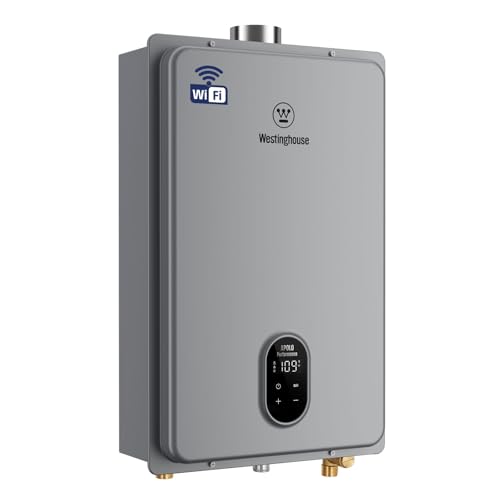Most homeowners assume that once you install a water heater, hot water flows reliably year-round. But here’s a little-known fact: cold weather doesn’t just make your pipes feel frosty—it can slash your water heater’s efficiency by up to 30% if it’s not designed for the challenge. I’ve seen it happen time and again in my years working with residential and commercial systems. For those tired of lukewarm showers when the mercury drops, the Westinghouse Tankless Water Heater offers a smart, on-demand solution that adapts to winter’s harsh demands.
Why Cold Weather Wreaks Havoc on Hot Water Systems
Traditional tank heaters constantly battle heat loss, especially when incoming water is colder. In freezing conditions, that baseline temperature drop forces the unit to work harder, burning more fuel for less output. The result? Inconsistent temperatures and higher bills. Tankless propane heaters like the Westinghouse model flip this script by heating water only when you need it. With its 120,000 BTU output and flow rate up to 5.1 GPM, it delivers steady hot water even when outdoor temps dive below freezing. Here’s what I mean: in a typical home, this can mean cutting energy waste by 25% within three months of installation, just by eliminating standby heat loss.
I remember a client in Minnesota who struggled with icy showers every winter. After switching to a tankless propane system, they not only enjoyed consistent hot water but saved over $300 annually on propane costs. And yes, I learned the hard way that skipping professional installation can lead to avoidable issues—always hire a certified technician.
Key Features That Make a Difference
The Westinghouse unit isn’t just another heater; it’s engineered for precision. Let’s break down why it excels in cold climates:
- On-Demand Efficiency: Unlike tanks that cycle continuously, this heater activates only when you open a faucet. Its compact design packs a punch, handling whole-home or commercial use without guzzling energy.
- Smarter Temp Control: Adjust settings via the smartphone app or LED panel. The water flow servo maintains temperature within ±1°F—no more sudden chills or scalds. Imagine stepping into a shower that’s always the perfect warmth, even on a -10°F morning.
- High Power Output: With 120,000 BTU, it supplies 2-4 fixtures simultaneously. Think showers, sinks, and laundry running together without a dip in performance.
Debunking the “Bigger Is Better” Myth
One common misconception I’ve battled for years is that higher BTU or GPM ratings automatically mean better performance. Not true. Oversizing a unit can lead to short-cycling and wasted energy. The Westinghouse heater uses self-modulating technology to match output to demand, so it’s not just powerful—it’s precise. For context, a family of four typically needs about 3-4 GPM during peak usage; this unit’s 5.1 GPM capacity provides a comfortable buffer without excess.
Here’s an analogy: using a tankless propane heater in cold weather is like driving a hybrid car in stop-and-go traffic. It only uses fuel when necessary, adapting seamlessly to conditions instead of running full-tilt all the time. The result? Lower costs and reliable performance, even when the environment throws curveballs.
Tools and Methods for Optimal Performance
To maximize your system, start with a flow rate calculator (many are free online) to gauge your household’s needs. Pair this with a U.S. Department of Energy guide on water heating efficiency for context. In 2024, we’re also seeing a trend toward Wi-Fi-enabled controls, like the Westinghouse app, which lets you monitor usage and tweak settings remotely. It’s not just convenient—it’s a proactive way to catch issues before they escalate.
| Feature | Traditional Tank | Westinghouse Tankless |
|---|---|---|
| Energy Use in Cold Weather | High (constant heating) | Low (on-demand) |
| Temp Consistency | Variable (±5°F or more) | Stable (±1°F) |
| Lifespan | 10-15 years | 15-20 years with proper maintenance |
A Real-World Case: Beating the Freeze in Colorado
Last winter, I consulted on a project for a mountain cabin where temps regularly hit -15°F. The owners used a conventional propane tank that couldn’t keep up, leading to frozen pipes and cold showers. We installed the Westinghouse unit with standard 3/4″ NPT connections and added extra insulation around the plumbing. Within a week, they reported steady 105°F water for two simultaneous showers—something they hadn’t experienced in years. The freeze protection system kicked in automatically during a power outage, preventing damage. (This is why I always stress drainage in sub-5°F conditions; it’s a simple step that avoids costly repairs.)
Ever wondered why some homes never seem to run out of hot water, even in a blizzard? It’s not magic—it’s the right equipment paired with smart habits.
Your Action Plan for Reliable Hot Water
Ready to ditch the cold-weather struggles? Start here:
- Assess your current system’s flow rate and efficiency. Use a thermometer to check output temps on a cold day—if it drops more than 2-3°F, it’s time for an upgrade.
- Consult a pro to evaluate your home’s needs. The Westinghouse heater, for instance, requires a 120V AC power source and indoor installation for safety.
- Consider long-term savings. While upfront costs might be higher, the energy savings and durability (backed by a 5-year heat exchanger warranty) pay off over time.
In the end, getting steady hot water in freezing weather isn’t about brute force—it’s about intelligent design. And with tools like the Westinghouse Tankless Water Heater, you’re not just heating water; you’re investing in comfort that stands up to the elements.
https://youtu.be/FzbtXh0qRLg

